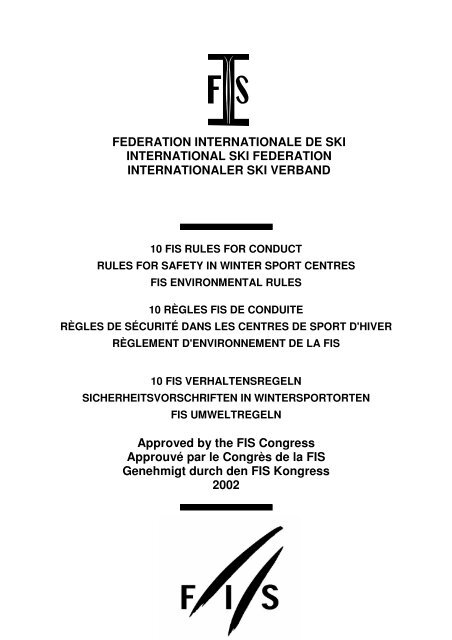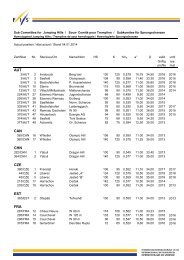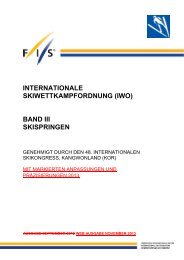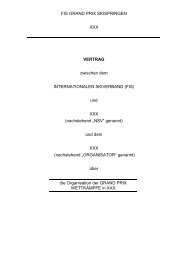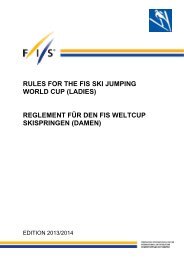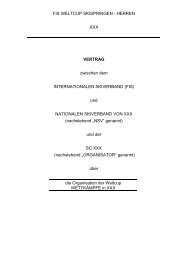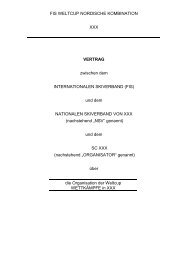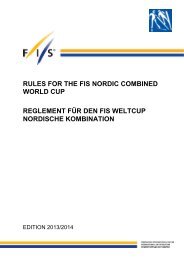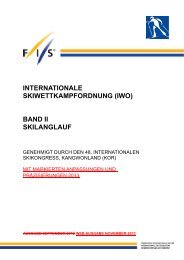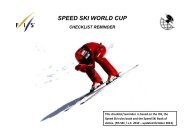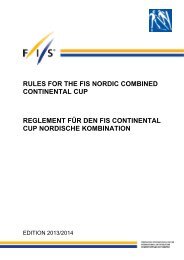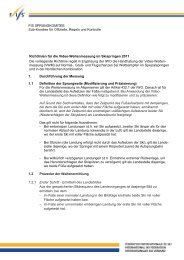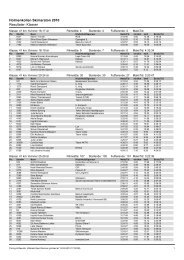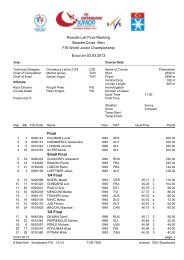10 Règles FIS Rules de conduite, Règles de Sécurité dans les ...
10 Règles FIS Rules de conduite, Règles de Sécurité dans les ...
10 Règles FIS Rules de conduite, Règles de Sécurité dans les ...
You also want an ePaper? Increase the reach of your titles
YUMPU automatically turns print PDFs into web optimized ePapers that Google loves.
FEDERATION INTERNATIONALE DE SKI<br />
INTERNATIONAL SKI FEDERATION<br />
INTERNATIONALER SKI VERBAND<br />
<strong>10</strong> <strong>FIS</strong> RULES FOR CONDUCT<br />
RULES FOR SAFETY IN WINTER SPORT CENTRES<br />
<strong>FIS</strong> ENVIRONMENTAL RULES<br />
<strong>10</strong> RÈGLES <strong>FIS</strong> DE CONDUITE<br />
RÈGLES DE SÉCURITÉ DANS LES CENTRES DE SPORT D'HIVER<br />
RÈGLEMENT D'ENVIRONNEMENT DE LA <strong>FIS</strong><br />
<strong>10</strong> <strong>FIS</strong> VERHALTENSREGELN<br />
SICHERHEITSVORSCHRIFTEN IN WINTERSPORTORTEN<br />
<strong>FIS</strong> UMWELTREGELN<br />
Approved by the <strong>FIS</strong> Congress<br />
Approuvé par le Congrès <strong>de</strong> la <strong>FIS</strong><br />
Genehmigt durch <strong>de</strong>n <strong>FIS</strong> Kongress<br />
2002
INTERNATIONAL SKI FEDERATION<br />
FEDERATION INTERNATIONALE DE SKI<br />
INTERNATIONALER SKI VERBAND<br />
Blochstrasse 2; CH- 3653 Oberhofen / Thunersee; Switzerland<br />
Telephone: +41 (33) 244 61 61<br />
Fax: +41 (33) 244 61 71<br />
Website:<br />
www.fis-ski.com<br />
Oberhofen, July 2002
Contents / In<strong>de</strong>x / Inhalt<br />
I. <strong>Ru<strong>les</strong></strong> for the Conduct of Skiers and Snowboar<strong>de</strong>rs with Comments......................2<br />
II. <strong>Ru<strong>les</strong></strong> of Conduct for Cross-Country Skiers ............................................................5<br />
III. <strong>Ru<strong>les</strong></strong> for Safety in Winter Sports Centers...............................................................6<br />
IV.<br />
V.<br />
Security on Ski- and Chair lifts ................................................................................9<br />
<strong>FIS</strong> Environmental <strong>Ru<strong>les</strong></strong> for Skiers and Snowboar<strong>de</strong>rs .......................................<strong>10</strong><br />
I.<br />
II.<br />
<strong>Règ<strong>les</strong></strong> <strong>de</strong> <strong>conduite</strong> du skieur <strong>de</strong> <strong>de</strong>scente et <strong>de</strong> snowboar<strong>de</strong>r.............................11<br />
Règlements <strong>de</strong> <strong>conduite</strong> pour skieurs <strong>de</strong> fond ......................................................14<br />
III. <strong>Règ<strong>les</strong></strong> <strong>de</strong> sécurité <strong>dans</strong> <strong>les</strong> centres <strong>de</strong> sport d'hiver ............................................15<br />
IV. La sécurité sur <strong>les</strong> téléskis et télésièges .............................................................158<br />
V. <strong>Règ<strong>les</strong></strong> d'environnement <strong>de</strong> la Fédération Internationale<br />
<strong>de</strong> ski pour <strong>les</strong> pratiquants <strong>de</strong> ski et <strong>de</strong> snowboard...............................................19<br />
I. Verhaltensregeln <strong>de</strong>r Skifahrer und Snowboar<strong>de</strong>r mit Kommentaren ...................20<br />
II. Verhaltensregeln für Langläufer............................................................................23<br />
III. Sicherheitsvorschriften in Wintersportorten...........................................................24<br />
IV. Die Sicherheit auf Ski- und Sesselliften ................................................................27<br />
V. Umweltregeln <strong>de</strong>s Internationalen Skiverban<strong>de</strong>s<br />
für Skisportler und Snowboar<strong>de</strong>r...........................................................................28<br />
- 1 -
I. <strong>Ru<strong>les</strong></strong> for the Conduct of Skiers and Snowboar<strong>de</strong>rs<br />
(Wording 2002)<br />
1. Respect for others<br />
A skier or snowboar<strong>de</strong>r must behave in such a way that he does not endanger<br />
or prejudice others.<br />
2. Control of speed and skiing or snowboarding<br />
A skier or snowboar<strong>de</strong>r must move in control. He must adapt his speed and<br />
manner of skiing or snowboarding to his personal ability and to the prevailing<br />
conditions of terrain, snow and weather as well as to the <strong>de</strong>nsity of traffic.<br />
3. Choice of route<br />
A skier or snowboar<strong>de</strong>r coming from behind must choose his route in such a<br />
way that he does not endanger skiers or snowboar<strong>de</strong>rs ahead.<br />
4. Overtaking<br />
A skier or snowboar<strong>de</strong>r may overtake another skier or snowboar<strong>de</strong>r above or<br />
below and to the right or to the left provi<strong>de</strong>d that he leaves enough space for the<br />
overtaken skier or snowboar<strong>de</strong>r to make any voluntary or involuntary<br />
movement.<br />
5. Entering, starting and moving upwards<br />
A skier or snowboar<strong>de</strong>r entering a marked run, starting again after stopping or<br />
moving upwards on the slopes must look up and down the slopes that he can<br />
do so without endangering himself or others.<br />
6. Stopping on the piste<br />
Un<strong>les</strong>s absolutely necessary, a skier or snowboar<strong>de</strong>r must avoid stopping on<br />
the piste in narrow places or where visibility is restricted. After a fall in such a<br />
place, a skier or snowboar<strong>de</strong>r must move clear of the piste as soon as possible.<br />
7. Climbing and <strong>de</strong>scending on foot<br />
A skier or snowboar<strong>de</strong>r either climbing or <strong>de</strong>scending on foot must keep to the<br />
si<strong>de</strong> of the piste.<br />
8. Respect for signs and markings<br />
A skier or snowboar<strong>de</strong>r must respect all signs and markings.<br />
9. Assistance<br />
At acci<strong>de</strong>nts, every skier or snowboar<strong>de</strong>r is duty bound to assist.<br />
<strong>10</strong>. I<strong>de</strong>ntification<br />
Every skier or snowboar<strong>de</strong>r and witness, whether a responsible party or not,<br />
must exchange names and addresses following an acci<strong>de</strong>nt.<br />
- 2 -
General Comments on the <strong>FIS</strong> <strong>Ru<strong>les</strong></strong><br />
(Wording 2002)<br />
Skiing and Snowboarding like all sports entail risks.<br />
The <strong>FIS</strong> <strong>Ru<strong>les</strong></strong> must be consi<strong>de</strong>red an i<strong>de</strong>al pattern of conduct for a responsible and<br />
careful skier or snowboar<strong>de</strong>r and their purpose is to avoid acci<strong>de</strong>nts on the piste.<br />
The <strong>FIS</strong> <strong>Ru<strong>les</strong></strong> apply to all skiers and snowboar<strong>de</strong>rs. The skier or snowboar<strong>de</strong>r is obliged<br />
to be familiar with and to respect them.<br />
If he fails to do so, his behaviour could expose him to civil and criminal liability in the event<br />
of an acci<strong>de</strong>nt.<br />
Rule 1<br />
Skiers and snowboar<strong>de</strong>rs are responsible not only for their own behaviour but also for their<br />
<strong>de</strong>fective equipment. This also applies to those using newly <strong>de</strong>veloped equipment.<br />
Rule 2<br />
Collisions usually happen because skiers or snowboar<strong>de</strong>rs are moving too fast, out of<br />
control or have failed to see others. A skier or snowboar<strong>de</strong>r must be able to stop, turn and<br />
move within the ambit of his own vision.<br />
In crow<strong>de</strong>d areas or in places where visibility is reduced, skiers and snowboar<strong>de</strong>rs must<br />
move slowly especially at the edge of a steep slope, at the bottom of a piste and within<br />
areas surrounding skilifts.<br />
Rule 3<br />
Skiing and snowboarding are free activity sports, where everyone may move where and as<br />
they please, provi<strong>de</strong>d that they abi<strong>de</strong> by these ru<strong>les</strong> and adapt their skiing and<br />
snowboarding to their personal ability and to the prevailing conditions on the mountain.<br />
The skier or snowboar<strong>de</strong>r in front has priority. The skier or snowboar<strong>de</strong>r moving behind<br />
another in the same direction must keep sufficient distance between himself and the other<br />
skier or snowboar<strong>de</strong>r so as to leave the preceding skier or snowboar<strong>de</strong>r enough space to<br />
make all his movements freely.<br />
Rule 4<br />
A skier or snowboar<strong>de</strong>r who overtakes another is wholly responsible for completing that<br />
manoeuvre in such a way to cause no difficulty to the skier or snowboar<strong>de</strong>r being<br />
overtaken. This responsibility rests with him until the overtaking manoeuvre has been<br />
completed. This rule applies even when overtaking a stationary skier or snowboar<strong>de</strong>r.<br />
Rule 5<br />
Experience proves that joining a piste or starting again after stopping are the sources of<br />
acci<strong>de</strong>nts. It is absolutely essential that a skier or snowboar<strong>de</strong>r finding himself in this<br />
situation enters the piste safely and without causing an obstruction or danger to himself or<br />
others.<br />
When he has started skiing or snowboarding properly again – even slowly – he has the<br />
benefit of rule 3 as against faster skiers and snowboar<strong>de</strong>rs coming from above or behind.<br />
- 3 -
The <strong>de</strong>velopment of carving skis and snowboards allows their users to carve and turn<br />
upwards on the slopes. Hence they move opposite to the general downhill traffic. They<br />
must, therefore, make sure in time that they can do so without endangering themselves<br />
and others.<br />
Rule 6<br />
Except on wi<strong>de</strong> pistes stops must be ma<strong>de</strong> at the si<strong>de</strong> of the piste. One must not stop in<br />
narrow places or where it is difficult to be seen from above.<br />
Rule 7<br />
Moving against the general direction poses unexpected obstac<strong>les</strong> for the skiers and<br />
snowboar<strong>de</strong>rs.<br />
Footprints damage the piste and can cause danger to skiers and snowboar<strong>de</strong>rs.<br />
Rule 8<br />
The <strong>de</strong>gree of difficulty of a piste is indicated in black, red, blue or green. A skier or<br />
snowboar<strong>de</strong>r is free to choose whichever piste he wants.<br />
The pistes are also marked with other signs showing direction or giving warnings of danger<br />
or closure. A sign closing a piste, like one <strong>de</strong>noting danger, must be strictly observed.<br />
Skiers and snowboar<strong>de</strong>rs should be aware that warning signs are posted in their own<br />
interests.<br />
Rule 9<br />
It is a cardinal principle for all sportsmen that they should ren<strong>de</strong>r assistance following an<br />
acci<strong>de</strong>nt in<strong>de</strong>pen<strong>de</strong>nt of any legal obligation to do so. Immediate First Aid should be given,<br />
the appropriate authorities alerted and the place of the acci<strong>de</strong>nt marked to warn other<br />
skiers and snowboar<strong>de</strong>rs.<br />
<strong>FIS</strong> hopes that a hit and run offence in skiing and snowboarding will incur a criminal<br />
conviction similar to hit and run offence on the road and that equivalent penalties will be<br />
imposed by all countries where such legislation is not already in force.<br />
Rule <strong>10</strong><br />
Witnesses are of great importance in establishing a full and proper report of an acci<strong>de</strong>nt<br />
and therefore everybody must consi<strong>de</strong>r that it is the duty as a responsible person to<br />
provi<strong>de</strong> information as a witness.<br />
Reports of the rescue service and of the police as well as photographs are of consi<strong>de</strong>rable<br />
assistance in <strong>de</strong>terming civil and criminal liability.<br />
- 4 -
II.<br />
<strong>Ru<strong>les</strong></strong> of Conduct for Cross-Country Skiers<br />
1. Respect for others<br />
A cross-country skier must ski in such a manner that he does not endanger or<br />
prejudice others.<br />
2. Respect for signs, direction and running style<br />
Trail marking signs must be respected on any trail marked with an indicated<br />
direction. A skier shall proceed only in that indicated direction and ski in the<br />
indicated running style.<br />
3. Choice of trails and tracks<br />
On cross-country trails with more than one packed track, a skier should chose<br />
the right-hand track.<br />
Skiers in groups must keep in the right track behind each other. With free<br />
running style, skiers shall keep to their right-hand-si<strong>de</strong> of the trail.<br />
4. Overtaking<br />
A skier is permitted to overtake and pass another skier to the left or right.<br />
A skier ahead is not obliged to give way to an overtaking skier, but should allow<br />
a faster skier to pass whenever this is possible.<br />
5. Encounter<br />
Cross-country skiers meeting while skiing opposite directions shall keep to their<br />
right.<br />
A <strong>de</strong>scending skier has priority.<br />
6. Po<strong>les</strong><br />
A cross-country skier shall make the utmost effort to keep his po<strong>les</strong> close to his<br />
body whenever near another skier.<br />
7. Control of speed<br />
A cross-country skier, and especially going downhill, shall always adapt his<br />
speed to his personal ability and to the prevailing terrain and visibility and to the<br />
traffic on the course.<br />
Every skier should keep a safe distance from the skiers ahead. As a last resort,<br />
an intentional fall should be used to avoid collision.<br />
8. Keeping trails and tracks clear<br />
A skier who stops must leave the trail. In case of a fall, he shall clear the trail<br />
without <strong>de</strong>lay.<br />
9. Acci<strong>de</strong>nt<br />
In case of an acci<strong>de</strong>nt, everyone should ren<strong>de</strong>r assistance.<br />
<strong>10</strong>. I<strong>de</strong>ntification<br />
Everybody at an acci<strong>de</strong>nt, whether witnesses, responsible parties or not, must<br />
establish their i<strong>de</strong>ntity.<br />
- 5 -
III.<br />
<strong>Ru<strong>les</strong></strong> for Safety in Winter Sports Centres<br />
A. General principle<br />
The safety in Winter sports centres can only be satisfactorily guaranteed by the<br />
collaboration of the following:<br />
- the local governing body or authority<br />
- all organisations responsible for means of uphill transports<br />
- the ski schools, instructors and gui<strong>de</strong>s<br />
- the skiers<br />
B. General organisation of the centres<br />
This means that these organisations are responsible for<br />
1. laying out, maintaining, signing and protecting the marked runs like pistes and<br />
itineraries (unpatrolled runs);<br />
2. organising a permanent rescue service for the marked ski runs and for the care<br />
of the injured;<br />
3. providing information for skiers regarding the layout and the <strong>de</strong>gree of difficulty<br />
of pistes and itineraries. They must also provi<strong>de</strong> weather forecasts and in<br />
particular warnings of potential avalanche danger.<br />
C. Skiing areas: pistes, itineraries (unpatrolled runs), off piste<br />
The concept of skiing areas in Europe has <strong>de</strong>veloped around the marked<br />
runs/pistes.<br />
1. The marked piste<br />
a) The pistes are classed according to their mounting <strong>de</strong>gree of difficulty by green,<br />
blue, red and black signs.<br />
b) On the piste, skiers are entitled to standards of safety as recognised by the<br />
national jurisdiction of that state.<br />
c) A piste must not be laid out over terrain exposed to avalanches.<br />
d) Pistes must be "opened" and "closed" every day.<br />
e) Both the entire length and immediate boundaries of pistes must be free from<br />
exceptional and abnormal danger points.<br />
f) There must be an organised permanent rescue service in operation from the<br />
opening to the closing of the piste.<br />
g) A skier is entitled to the same standard of safety even where for whatever<br />
reason an area operator has opened or laid out a piste which has not been<br />
marked.<br />
- 6 -
2. The itinerary (unpatrolled run)<br />
a) Itineraries should not be laid out in areas where the skier might encounter<br />
unusual and unexpected dangers.<br />
b) The marking must be continued until the end of the itinerary.<br />
c) Any avalanche danger should be signed in the resort and at the lower lift station<br />
leading to the start of the itinerary which itself should be closed off.<br />
d) Itineraries are not gra<strong>de</strong>d according to their <strong>de</strong>gree of difficulty. Any difficulties<br />
however, which are beyond the capability of the skier of medium ability must be<br />
indicated on the information boards in the resort.<br />
e) Itineraries are skied at the skiers own risk or at the risk of his instructor.<br />
3. Off piste skiing<br />
Except for the obligation of the ski centre to provi<strong>de</strong> information regarding the<br />
weather and especially avalanche dangers, any skiing off piste is un<strong>de</strong>rtaken at<br />
the skier's own risk or at the risk of his instructor or gui<strong>de</strong>.<br />
4. Information for the skier provi<strong>de</strong>d by the ski centres, e.g. information<br />
boards, piste maps, pamphlets etc.<br />
a) The pistes will be shown by continuous lines of the colour corresponding to their<br />
<strong>de</strong>gree of difficulty.<br />
b) The itineraries will be shown by dotted lines or by continuous lines in yellow or<br />
orange.<br />
5. The concept of pistes<br />
In countries where the organisation of skiing does not stem from the concept of<br />
pistes, but from that of a skiing area within a <strong>de</strong>fined boundary, the ski area<br />
operator must within this area protect skiers from foreseeable dangers which<br />
are not obvious or which cannot be foreseen by a careful skier.<br />
D. Operators of means of uphill transport<br />
1. Cable cars and mountain railways<br />
As the user takes no active part in this transportation, the operator has the<br />
following obligation to the user: that of transporting him safely from the point of<br />
<strong>de</strong>parture to the point of arrival at the operators risk.<br />
2. Drag lifts, chair lifts and other machines in continuous movement<br />
Subject to national, legal and administrative measures, the operator must<br />
ensure<br />
a) that the machines are maintained in good working or<strong>de</strong>r by sufficient number of<br />
competent staff;<br />
- 7 -
) a<strong>de</strong>quate management and maintenance of the areas for picking up and<br />
<strong>de</strong>parture from the lift together with warning signs pointing out difficulties in the<br />
terrain;<br />
c) the management, and, as necessary, protection of the queues of waiting<br />
people;<br />
d) maintenance of the uphill transport track;<br />
e) protection of the dangerous parts of the track, and provi<strong>de</strong> a user in difficulty<br />
with the means of arresting his fall and <strong>de</strong>scending safely;<br />
f) to ensure that by overseeing the track immediate action can be taken to warn,<br />
avoid or limit any danger;<br />
g) the staff of the operator has a general duty to assist users, especially children,<br />
and in the case of obvious difficulty, or at the request of the user;<br />
h) to provi<strong>de</strong> notice boards <strong>de</strong>scribing how users should behave on the lift.<br />
i) A user must have sufficient physical and technical skill to use machines in<br />
continuous movement so that he can be pulled up the track normally.<br />
j) In addition to the elementary ru<strong>les</strong> of care the user should pay attention to the<br />
directions, written or oral, of the operator.<br />
E. The ski schools, instructors and gui<strong>de</strong>s<br />
1. The ski schools, instructors and gui<strong>de</strong>s must teach pupils how to ski safely,<br />
which means teaching the technique of skiing and the ru<strong>les</strong> of conduct for<br />
skiers.<br />
2. The ski schools are responsible for placing their pupils into different classes<br />
according to their standard of skiing.<br />
3. The ski schools, instructors and gui<strong>de</strong>s must never allow their pupils to take any<br />
risk beyond their capability especially taking into account the snow and weather<br />
conditions.<br />
4. The instructors must remind their pupils that during instruction they have no<br />
particular priority on the piste and that they should at all times respect the ru<strong>les</strong><br />
of conduct for skiers.<br />
F. The skiers<br />
Except for the negligence of others all skiers ski at their own risk.<br />
Skiers must at all times respect the ru<strong>les</strong> of conduct for skiers.<br />
G. Cancellation<br />
This document replaces all other safety instructions concerning in the Winter<br />
sports centres previously adopted by the <strong>FIS</strong>."<br />
- 8 -
IV.<br />
Security on Ski- and Chair lifts<br />
The <strong>FIS</strong> acting as the representative of skiers requests:<br />
a) Supervision of the operation of moving machinery by an a<strong>de</strong>quate and<br />
personnel.<br />
b) Satisfactory <strong>de</strong>sign and maintenance of the loading and unloading areas to<br />
prevent possible difficulties.<br />
c) The <strong>de</strong>sign and protection of skiers' waiting lines.<br />
d) The proper maintenance of ski trails and slopes.<br />
e) The protection of the dangerous area of a trail so as to give the skiers in<br />
difficulty for whatever cause the ability to <strong>de</strong>scend without danger.<br />
f) Supervision of the area to permit immediate action in or<strong>de</strong>r to anticipate, avoid<br />
or prevent danger.<br />
g) The operating personnel has a <strong>de</strong>finite responsibility to help in case of obvious<br />
trouble or at the request of a skier.<br />
h) The use of sign boards to give notice to the skier of the care required to avoid<br />
danger.<br />
In addition the <strong>FIS</strong> reminds that:<br />
1. The skier must be in possession of sufficient physical and technical ability to<br />
use the mechanical equipment and to ski normally on the ski track.<br />
2. Besi<strong>de</strong> the ru<strong>les</strong> of normal care the skier must respect the particular regulations<br />
drawn up by the owner of the ski area.<br />
- 9 -
V. <strong>FIS</strong> Environmental <strong>Ru<strong>les</strong></strong> for Skiers and Snowboar<strong>de</strong>rs<br />
All over the world skiers and snowboar<strong>de</strong>rs enjoy the open country. Nature<br />
gives home to animals and plants growing in vulnerable soil. Nature protects<br />
human life, too. Everybody is responsible for the preservation of the landscape<br />
in or<strong>de</strong>r to enable us to ski and snowboard in an intact environment far in the<br />
future. Sustainable skiing and snowboard must be guaranteed. Therefore the<br />
<strong>FIS</strong> asks all skiers and snowboar<strong>de</strong>rs to respect the following ru<strong>les</strong>:<br />
1. Gather information about the area you choose. Prefer those resorts which take<br />
care of the environment.<br />
2. When travelling to your area be environmentally conscious by using means of<br />
transportation with a minimum of pollution - bus, train.<br />
3. When using a private car, try to travel in company avoiding empty seats.<br />
4. At your resort don’t use your own car anymore, take the ski bus.<br />
5. Go skiing and snowboarding only when there is a sufficient cover of snow on<br />
the slopes.<br />
6. Keep to signed ski runs and trails.<br />
7. Pay attention to any special marks on courses and keep off closed tracks.<br />
8. Never ski and snowboard off allowed piste, especially not in woo<strong>de</strong>d areas.<br />
9. Do not <strong>de</strong>viate into protected areas. Take care of any animals and plants.<br />
<strong>10</strong>. Do not leave your waste, take it with you.<br />
- <strong>10</strong> -
I. <strong>Règ<strong>les</strong></strong> <strong>de</strong> Conduite du Skieur <strong>de</strong> Descente et <strong>de</strong> Snowboar<strong>de</strong>r<br />
(Rédaction 2002)<br />
1. Respect d'autrui<br />
Tout skieur et snowboar<strong>de</strong>r doit se comporter <strong>de</strong> telle manière qu'il ne puisse<br />
mettre autrui en danger ou lui porter préjudice.<br />
2. Maîtrise <strong>de</strong> la vitesse et du comportement<br />
Tout skieur et snowboar<strong>de</strong>r doit <strong>de</strong>scendre à vue. Il doit adapter sa vitesse et<br />
son comportement à ses capacités personnel<strong>les</strong> ainsi qu'aux conditions<br />
généra<strong>les</strong> du terrain, <strong>de</strong> la neige, du temps et à la <strong>de</strong>nsité <strong>de</strong> la circulation sur<br />
<strong>les</strong> pistes.<br />
3. Maîtrise <strong>de</strong> la direction<br />
Le skieur et snowboar<strong>de</strong>r amont, dont la position dominante permet le choix<br />
d'une trajectoire, doit prévoir une direction qui assure la sécurité du skieur et<br />
snowboar<strong>de</strong>r aval.<br />
4. Dépassement<br />
Le dépassement peut s'effectuer, par amont ou par aval, par la droite ou par la<br />
gauche, mais toujours <strong>de</strong> manière assez large pour prévenir <strong>les</strong> évolutions du<br />
skieur et snowboar<strong>de</strong>r dépassé.<br />
5. Pénétrer et s'engager sur la piste ainsi que virer vers l'amont<br />
Tout skieur et snowboar<strong>de</strong>r qui pénètre sur une piste <strong>de</strong> <strong>de</strong>scente, s'engage<br />
après un stationnement ou exécute un virage vers l'amont doit s'assurer par un<br />
examen <strong>de</strong> l'amont et <strong>de</strong> l'aval, qu'il peut le faire sans danger pour lui et pour<br />
autrui.<br />
6. Stationnement<br />
Tout skieur et snowboar<strong>de</strong>r doit éviter <strong>de</strong> stationner sans nécessité sur <strong>les</strong><br />
pistes <strong>dans</strong> <strong>les</strong> passages étroits ou sans visibilité. En cas <strong>de</strong> chute le skieur et<br />
snowboar<strong>de</strong>r doit dégager la piste le plus vite possible.<br />
7. Montée et <strong>de</strong>scente à pied<br />
Le skieur et snowboar<strong>de</strong>r qui monte ne doit utiliser que le bord <strong>de</strong> la piste. Il en<br />
est <strong>de</strong> même du skieur et snowboar<strong>de</strong>r qui <strong>de</strong>scend à pied.<br />
8. Respect du balisage et <strong>de</strong> la signalisation<br />
Tout skieur et snowboar<strong>de</strong>r doit respecter le balisage et la signalisation.<br />
9. Assistance<br />
En cas d'acci<strong>de</strong>nt tout skieur et snowboar<strong>de</strong>r doit prêter secours.<br />
<strong>10</strong>. I<strong>de</strong>ntification<br />
Tout skieur et snowboar<strong>de</strong>r témoin ou partie responsable ou non d'un acci<strong>de</strong>nt<br />
est tenu <strong>de</strong> faire connaître son i<strong>de</strong>ntité.<br />
- 11 -
Commentaire général aux <strong>Règ<strong>les</strong></strong> <strong>FIS</strong><br />
(Rédaction 2002)<br />
Le ski et le snowboard comme tout sport, comportent <strong>de</strong>s risques.<br />
Les règ<strong>les</strong> <strong>FIS</strong> constituent le cliché idéal du comportement du skieur et snowboar<strong>de</strong>r<br />
diligent, pru<strong>de</strong>nt et conscient. El<strong>les</strong> ont pour but d'éviter <strong>de</strong>s acci<strong>de</strong>nts sur <strong>les</strong> pistes <strong>de</strong><br />
ski.<br />
Le règ<strong>les</strong> <strong>FIS</strong> s'appliquent à tous <strong>les</strong> skieurs et snowboar<strong>de</strong>rs qui doivent <strong>les</strong> connaître et<br />
<strong>les</strong> respecter.<br />
Celui qui provoque un acci<strong>de</strong>nt en infraction <strong>de</strong>s règ<strong>les</strong> peut être civilement ou<br />
pénalement responsable.<br />
Règle 1<br />
Le skieur et snowboar<strong>de</strong>r est responsable non seulement <strong>de</strong> son comportement fautif<br />
mais aussi <strong>de</strong> son matériel défaillant, même nouvellement développé.<br />
Règle 2<br />
Les collisions sont souvent la conséquence d'une vitesse excessive, d'un comportement<br />
incontrôlé ou d'une observation insuffisante <strong>de</strong> la circulation sur la piste. Le skieur et<br />
snowboar<strong>de</strong>r doit pouvoir s'arrêter, virer ou évoluer à la limite <strong>de</strong> sa visibilité.<br />
Il doit aller lentement <strong>dans</strong> <strong>les</strong> zones encombrées et notamment au sommet, au bas <strong>de</strong><br />
pistes et aux abords <strong>de</strong>s remontées mécaniques.<br />
Règle 3<br />
Le ski et le snowboard sont <strong>de</strong>s sports d'évolution libre où chacun peut aller à sa<br />
convenance mais en respectant <strong>les</strong> règ<strong>les</strong>, en tenant compte <strong>de</strong> ses capacités<br />
personnel<strong>les</strong> et du contexte momentané.<br />
La priorité est dû au skieur et snowboar<strong>de</strong>r qui précè<strong>de</strong>. Celui qui avance <strong>de</strong>rrière un autre<br />
doit conserver une distance suffisante pour prévenir toutes évolutions du skieur et<br />
snowboar<strong>de</strong>r qui le précè<strong>de</strong>.<br />
Règle 4<br />
Les obligations du skieur et snowboar<strong>de</strong>r qui en dépasse un autre restent impératives<br />
jusqu'à la complète exécution du dépassement et <strong>de</strong> telle façon que ce dépassement ne<br />
cause aucune difficulté au skieur et snowboar<strong>de</strong>r dépassé. Cette obligation s'impose aussi<br />
au dépassement d'un skieur et snowboar<strong>de</strong>r arrêté.<br />
Règle 5<br />
L'expérience prouve que la pénétration ou le départ après un arrêt sur la piste peuvent<br />
être la cause d'un acci<strong>de</strong>nt. Il est donc impératif que le skieur et le snowboar<strong>de</strong>r qui<br />
démarre, s'insère harmonieusement et sans danger pour lui et pour autrui <strong>dans</strong> la<br />
circulation générale <strong>de</strong> <strong>de</strong>scente.<br />
Lorsqu'il se trouve alors en mouvement – bien que lentement – il jouit <strong>de</strong> nouveau du<br />
privilège selon la règle 3 envers <strong>les</strong> skieurs et snowboar<strong>de</strong>rs plus vites venant d'en haut<br />
ou par <strong>de</strong>rrière.<br />
- 12 -
Le développement <strong>de</strong> skis carving et <strong>de</strong> snowboards permet aux usagers d'exécuter <strong>de</strong>s<br />
virages vers l'amont. En virant vers l'amont, <strong>les</strong> usagers se déplacent à contresens du<br />
mouvement général <strong>de</strong> <strong>de</strong>scente. Il est donc impératif que <strong>les</strong> skieurs et snowboar<strong>de</strong>rs qui<br />
exécutent <strong>de</strong>s virages vers l'amont s'assurent à temps par un examen <strong>de</strong> l'amont qu'ils<br />
peuvent le faire sans danger pour eux et pour autrui.<br />
Règle 6<br />
A l'exception <strong>de</strong>s pistes larges le stationnement doit se faire sur le bord <strong>de</strong> la piste. Il n'est<br />
pas tolérable <strong>dans</strong> <strong>les</strong> passages étroits ou sans visibilité <strong>de</strong> l'amont.<br />
Règle 7<br />
Les évolutions à contresens <strong>de</strong> la circulation générale sont perturbatrices et imprévisib<strong>les</strong><br />
<strong>de</strong>s autres skieurs et snowboar<strong>de</strong>rs.<br />
Les traces profon<strong>de</strong>s faites par <strong>les</strong> pieds sont dangereuses.<br />
Règle 8<br />
Les pistes sont balisées selon leur <strong>de</strong>gré <strong>de</strong> difficulté décroissante en noir, rouge, bleu,<br />
vert. Le skieur et le snowboar<strong>de</strong>r est libre <strong>de</strong> choisir sa piste.<br />
Les pistes sont équipées d'une signalisation <strong>de</strong> danger et <strong>de</strong> barrage (fermeture). Il est<br />
impératif <strong>de</strong> respecter cette signalisation mise en place <strong>dans</strong> l'intérêt <strong>de</strong>s skieurs et<br />
snowboar<strong>de</strong>rs.<br />
Règle 9<br />
L'assistance au skieur et snowboar<strong>de</strong>r est une obligation <strong>de</strong> morale sportive lorsqu'elle<br />
n'est pas une obligation légale. Elle consiste à donner <strong>les</strong> premiers secours, à alerter le<br />
service <strong>de</strong> sécurité et à protéger l'endroit <strong>de</strong> l'acci<strong>de</strong>nt.<br />
La <strong>FIS</strong> espère que le délit <strong>de</strong> fuite à ski et à snowboard sera sanctionné pénalement<br />
comme le délit <strong>de</strong> fuite sur la route, <strong>dans</strong> tous <strong>les</strong> pays où la législation ne le prévoit pas<br />
déjà.<br />
Règle <strong>10</strong><br />
La relation <strong>de</strong>s témoins est d'une gran<strong>de</strong> importance pour la constitution d'un dossier<br />
d'acci<strong>de</strong>nt. Chacun doit donc remplir ce <strong>de</strong>voir moral d'homme conscient.<br />
Les rapports <strong>de</strong>s services <strong>de</strong> sauvetage et <strong>de</strong> la police ainsi que <strong>de</strong>s photos ai<strong>de</strong>nt<br />
considérablement à déterminer <strong>les</strong> éventuel<strong>les</strong> responsabilités.<br />
- 13 -
II.<br />
Règlements <strong>de</strong> <strong>conduite</strong> pour skieurs <strong>de</strong> fond<br />
1. Respect d'autrui<br />
Tout skieur <strong>de</strong> fond doit se comporter <strong>de</strong> telle manière qu'il ne puisse mettre<br />
autrui en danger ou lui porter préjudice.<br />
2. Respect <strong>de</strong> la signalisation, direction et technique<br />
Le skieur doit respecter le balisage et la signalisation. Sur <strong>les</strong> traces/pistes, il<br />
doit suivre la direction et la technique imposées.<br />
3. Choix <strong>de</strong> la trace/piste<br />
S'il y a plusieurs traces, le skieur doit utiliser la trace <strong>de</strong> droite. Des skieurs en<br />
groupe doivent circuler en fil sur la trace <strong>de</strong> droite. En technique libre, il faut<br />
circuler à droite <strong>de</strong> la piste.<br />
4. Dépassement<br />
Le dépassement peut s'effectuer par la droite ou par la gauche, mais toujours<br />
sans danger pour autrui.<br />
Le skieur précé<strong>de</strong>nt n'est pas obligé <strong>de</strong> cé<strong>de</strong>r. Mais il <strong>de</strong>vrait s'écarter pour<br />
laisser passer un skieur, s'il peut le faire sans danger.<br />
5. Croisement<br />
Lors <strong>de</strong>s croisements sur <strong>les</strong> pistes à double sens <strong>de</strong> marche, chacun doit<br />
cé<strong>de</strong>r à droite.<br />
Le skieur qui <strong>de</strong>scend a la priorité sur celui qui monte.<br />
6. Bâtons<br />
Lors <strong>de</strong> croisements ou dépassements - que l'on soit le skieur qui dépasse ou<br />
le skieur dépassé - il faut serrer <strong>les</strong> bâtons près du corps.<br />
7. Maîtrise <strong>de</strong> la vitesse<br />
Tout skieur, et notamment <strong>dans</strong> <strong>les</strong> pentes, doit adapter sa vitesse à ses<br />
capacités personnel<strong>les</strong> ainsi qu'aux conditions généra<strong>les</strong> du terrain, <strong>de</strong> la<br />
visibilité et du trafic sur la piste.<br />
Chacun <strong>de</strong>vra conserver une distance suffisante avec <strong>les</strong> skieurs précé<strong>de</strong>nts.<br />
En <strong>de</strong>rnier recours, la chute spontanée peut s'imposer pour éviter une collision.<br />
8. Stationnement<br />
L'arrêt doit s'effectuer en <strong>de</strong>hors <strong>de</strong> la trace/piste. Celui qui tombe doit libérer la<br />
trace/piste le plus rapi<strong>de</strong>ment possible.<br />
9. Acci<strong>de</strong>nt<br />
En cas d'acci<strong>de</strong>nt, toute personne doit prêter secours.<br />
<strong>10</strong>. I<strong>de</strong>ntification<br />
Toute personne, témoin ou partie responsable ou non d'un acci<strong>de</strong>nt, est tenue<br />
<strong>de</strong> faire connaître son i<strong>de</strong>ntité.<br />
- 14 -
III.<br />
<strong>Règ<strong>les</strong></strong> <strong>de</strong> sécurité <strong>dans</strong> <strong>les</strong> centres <strong>de</strong> sport d'hiver<br />
A. Idée générale<br />
La sécurité <strong>dans</strong> <strong>les</strong> centres <strong>de</strong> sport d'hiver ne peut être valablement assurée<br />
que par une collaboration entre:<br />
- <strong>les</strong> autorités responsable <strong>de</strong> l'organisation matérielle générale<br />
- <strong>les</strong> remontées mécaniques<br />
- <strong>les</strong> éco<strong>les</strong> <strong>de</strong> ski, moniteurs et gui<strong>de</strong>s<br />
- es usagers du ski<br />
B. Organisation générale <strong>de</strong>s centres<br />
Elle implique <strong>les</strong> organismes chargés:<br />
1. du tracé, <strong>de</strong> l'entretien, du balisage et <strong>de</strong> la protection <strong>de</strong>s pistes ou itinéraires;<br />
2. <strong>de</strong> l'organisation d'un service permanent <strong>de</strong> secours sur piste et <strong>de</strong> soins aux<br />
b<strong>les</strong>sés;<br />
3. <strong>de</strong> l'information <strong>de</strong>s usagers du ski quant aux tracés et difficultés <strong>de</strong>s pistes ou<br />
itinéraires, ainsi que du temps prévu et notamment <strong>de</strong>s dangers d'avalanches.<br />
C. Le domaine skiable: piste, itinéraire <strong>de</strong> ski, hors piste<br />
L'organisation <strong>de</strong> domaine skiable a été faite principalement en Europe à partir<br />
<strong>de</strong> la piste balisée.<br />
1. La piste balisée<br />
a) Les pistes balisées sont classées, selon leur ordre <strong>de</strong> difficultés croissantes en<br />
vert, bleu, rouge et noir.<br />
b) Sur la piste balisée, <strong>les</strong> usagers jouissent d'un droit à la sécurité, consacré par<br />
<strong>les</strong> jurispru<strong>de</strong>nces nationa<strong>les</strong>.<br />
c) La piste ne doit pas être tracée <strong>dans</strong> <strong>les</strong> zones avalancheuses.<br />
d) Elle doit être "ouverte" et "fermée" chaque jour.<br />
e) Elle doit être sans dangers objectifs exceptionnels et atypiques sur tout son<br />
parcours, y compris à ses abords immédiats.<br />
f) Le secours doit y être assuré en permanence entre l'ouverture et la fermeture.<br />
g) Le skieur a droit à la même sécurité <strong>dans</strong> le cas où pour une quelconque<br />
opportunité le centre a ouvert ou tracé une piste non "balisée".<br />
2. L'itinéraire <strong>de</strong> ski<br />
a) L'itinéraire <strong>de</strong> ski ne doit pas être fléché en direction <strong>de</strong> zones où le skieur<br />
pourrait rencontrer <strong>de</strong>s dangers atypiques.<br />
b) Le fléchage doit être répété jusqu'au bas <strong>de</strong> la <strong>de</strong>scente.<br />
- 15 -
c) Les dangers d'avalanches seront signalés à la station et au bas <strong>de</strong>s remontées<br />
mécaniques menant au départ <strong>de</strong> l'itinéraire qui <strong>de</strong>vra être materiellement<br />
barré.<br />
d) Les itinéraires ne sont pas différenciés selon leurs <strong>de</strong>grés <strong>de</strong> difficulté mais <strong>les</strong><br />
difficultés qui excè<strong>de</strong>nt la capacité d'un skieur moyen <strong>de</strong>vront être signalées sur<br />
<strong>les</strong> documents <strong>de</strong> la station.<br />
e) L'itinéraire ainsi défini est parcouru sous la seule responsabilité <strong>de</strong> l'usager, ou<br />
<strong>de</strong> son moniteur.<br />
3. Le ski hors piste<br />
Sous réserve <strong>de</strong>s obligations d'information <strong>de</strong> centre quant à la météorologie et<br />
notamment quant aux dangers d'avalanches le ski hors piste est pratiqué sous<br />
la seule responsabilité <strong>de</strong>s usagers, <strong>de</strong> leurs moniteurs ou gui<strong>de</strong>s.<br />
4. Information <strong>de</strong>s usagers par <strong>les</strong> documents <strong>de</strong>s centres<br />
a) Les pistes figureront en traits continus <strong>de</strong> la couleur correspondante à leur<br />
<strong>de</strong>gré <strong>de</strong> difficulté.<br />
b) Les itinéraires <strong>de</strong>s ski figureront en traits pointillés ou en traits continus <strong>de</strong><br />
couleur jaune ou orange.<br />
5. La piste balisée<br />
Dans <strong>les</strong> pays dont l'organisation <strong>de</strong> ski n'est pas prévue à partir <strong>de</strong> la piste<br />
balisée, mais à partir d'un domaine skiable géographiquement délimité, la<br />
sécurité du skieur doit être assurée <strong>dans</strong> l'ensemble du domaine contre <strong>les</strong><br />
dangers prévisib<strong>les</strong> <strong>de</strong> la montagne ou ceux que le skieur diligent ne peut<br />
imaginer.<br />
D. Les remontées mécaniques<br />
1. Téléphériques et funiculaires<br />
L'usager ne prenant aucune part active à son transport, l'exploitant doit à<br />
l'usager une obligation <strong>de</strong> résultat: celle <strong>de</strong> le transporter sain et sauf du départ<br />
à l'arrivée et ce sous sa seule responsabilité.<br />
2. Téléskis, télésièges, engins en mouvement continu<br />
Sous réserve <strong>de</strong>s dispositions léga<strong>les</strong> et administratives nationa<strong>les</strong> et<br />
éventuellement au surplus l'exploitant doit assurer:<br />
a) la surveillance du bon fonctionnement <strong>de</strong>s engins en marche par un personnel<br />
suffisant et compétent;<br />
b) l'aménagement et l'entretien adéquats <strong>de</strong>s aires <strong>de</strong> départ et d'arrivée en<br />
fonction <strong>de</strong>s débits prévus et <strong>de</strong>s difficultés naturel<strong>les</strong>;<br />
c) l'aménagement et la protection éventuels <strong>de</strong>s fi<strong>les</strong> d'attente;<br />
d) l'entretien <strong>de</strong> la trace;<br />
- 16 -
e) la protection <strong>de</strong> la trace sur ses parcours dangereux et donner à l'usager en<br />
difficulté <strong>les</strong> moyens d'arrêter sa glissa<strong>de</strong> et la possibilité <strong>de</strong> <strong>de</strong>scendre sans<br />
danger;<br />
f) la surveillance <strong>de</strong> la trace permettant l'intervention immédiate pour prévenir,<br />
éviter ou limiter un danger;<br />
g) le personnel d'exploitation a en général un <strong>de</strong>voir d'assistance notamment pour<br />
<strong>les</strong> enfants et en cas <strong>de</strong> difficulté évi<strong>de</strong>nte ou à la <strong>de</strong>man<strong>de</strong> <strong>de</strong> l'usager;<br />
h) la signalisation par panneaux <strong>de</strong>scriptifs du comportement nécessaire <strong>de</strong><br />
l'usager;<br />
i) l'usager doit être en possession <strong>de</strong>s moyens physiques et techniques suffisants<br />
pour utiliser <strong>de</strong>s engins en marche continue et glisser normalement sur la trace;<br />
j) au surplus <strong>de</strong>s règ<strong>les</strong> <strong>de</strong> pru<strong>de</strong>nce élémentaire l'usager doit respecter <strong>les</strong><br />
prescriptions formulées par l'exploitant.<br />
E. Les éco<strong>les</strong> <strong>de</strong> ski, moniteurs et gui<strong>de</strong>s<br />
1. Les éco<strong>les</strong> <strong>de</strong> ski, <strong>les</strong> moniteurs et <strong>les</strong> gui<strong>de</strong>s doivent apprendre aux usagers<br />
l'art <strong>de</strong> skier en sécurité, savoir: la technique du ski et <strong>les</strong> règ<strong>les</strong> <strong>de</strong> <strong>conduite</strong> du<br />
skieur.<br />
2. Les éco<strong>les</strong> sont responsable du classement <strong>de</strong>s élèves <strong>dans</strong> <strong>les</strong> différents<br />
cours.<br />
3. Les éco<strong>les</strong>, <strong>les</strong> moniteurs et <strong>les</strong> gui<strong>de</strong>s ne doivent jamais faire prendre aux<br />
élèves <strong>de</strong>s risques disproportionnés à leur capacité y compris en fonction <strong>de</strong> la<br />
qualité <strong>de</strong> la neige et du temps.<br />
4. Les moniteurs doivent rappeler à leurs élèves qu'ils n'ont, lors <strong>de</strong>s cours,<br />
aucune priorité particulière sur la piste et qu'ils doivent constamment respecter<br />
<strong>les</strong> règ<strong>les</strong> <strong>de</strong> <strong>conduite</strong> du skieur.<br />
F. Les usagers du ski<br />
Sous réserves <strong>de</strong>s fautes commises par autrui, <strong>les</strong> skieurs skient à leurs<br />
risques et périls.<br />
Ils doivent en toute occasion respecter totalement <strong>les</strong> règ<strong>les</strong> <strong>de</strong> <strong>conduite</strong> <strong>de</strong><br />
skieur.<br />
G. Annulation<br />
Le présent document remplace <strong>les</strong> différents travaux sur la sécurité <strong>dans</strong> <strong>les</strong><br />
centres <strong>de</strong> sport d'hiver préalablement adoptés par le <strong>FIS</strong>."<br />
- 17 -
IV.<br />
La sécurité sur <strong>les</strong> téléskis et télésièges<br />
Dans le cadre <strong>de</strong> la recherche <strong>de</strong>s conditions d'une sécurité optimale sur <strong>les</strong><br />
téléskis et télésièges, sous réserves <strong>de</strong>s dispositions léga<strong>les</strong> et administratives<br />
nationa<strong>les</strong>, la <strong>FIS</strong> agissant comme représentant <strong>de</strong>s usagers, <strong>de</strong>man<strong>de</strong>:<br />
a) La surveillance du bon fonctionnement <strong>de</strong>s engins en marche, par un personnel<br />
suffisant et compétent.<br />
b) L'aménagement et l'entretien adéquat <strong>de</strong>s aires <strong>de</strong> départ et d'arrivée en<br />
fonction <strong>de</strong> débits prévus et <strong>de</strong>s difficultés naturel<strong>les</strong>.<br />
c) L'aménagement et la protection éventuelle <strong>de</strong>s fi<strong>les</strong> d'attente.<br />
d) L'entretien <strong>de</strong> la trace.<br />
e) La protection <strong>de</strong> la trace sur ses parcours dangereux et donner à l'usager en<br />
difficulté, en tout état <strong>de</strong> cause, une possibilité <strong>de</strong> <strong>de</strong>scendre sans danger.<br />
f) La surveillance <strong>de</strong> la trace permettant l'intervention immédiate pour prévenir,<br />
éviter ou limiter un danger.<br />
g) Le personnel d'exploitation a en général un <strong>de</strong>voir d'assistance et notamment<br />
en cas <strong>de</strong> difficulté évi<strong>de</strong>nte ou à la <strong>de</strong>man<strong>de</strong> <strong>de</strong> l'usager.<br />
h) La signalisation par panneaux <strong>de</strong>scriptifs du comportement nécessaire <strong>de</strong><br />
l'usager.<br />
Par ailleurs la <strong>FIS</strong> rappelle:<br />
1. L'usager doit être en possession <strong>de</strong>s moyens physiques et techniques<br />
suffisants pour utiliser <strong>de</strong>s engins en marche continue et glisser normalement<br />
sur la trace.<br />
2. Au surplus <strong>de</strong>s règ<strong>les</strong> <strong>de</strong> pru<strong>de</strong>nce élémentaire, l'usager doit respecter <strong>les</strong><br />
prescriptions formulées par l'exploitant.<br />
- 18 -
V. <strong>Règ<strong>les</strong></strong> d'environnement <strong>de</strong> la Fédération Internationale <strong>de</strong> ski<br />
pour <strong>les</strong> pratiquants <strong>de</strong> ski et <strong>de</strong> snowboard<br />
Les pratiquants <strong>de</strong> ski et <strong>de</strong> snowboard <strong>dans</strong> le mon<strong>de</strong> entier vivent en pleine<br />
nature. Elle est l'habitat <strong>de</strong> la faune et <strong>de</strong> la flore qui prospère sur un terrain<br />
sensible. Elle protège aussi l'homme en personne. Tous sont appelés à<br />
protéger le paysage afin <strong>de</strong> pouvoir également pratiquer à l'avenir le ski et le<br />
snowboard <strong>dans</strong> un environnement intact et <strong>de</strong> <strong>les</strong> conserver durablement. Par<br />
conséquent, la Fédération Internationale <strong>de</strong> Ski invite <strong>les</strong> pratiquants <strong>de</strong> ski et<br />
<strong>de</strong> snowboard à respecter <strong>les</strong> règ<strong>les</strong> suivantes:<br />
1. Informez-vous sur territoire choisi. Soutenez <strong>les</strong> endroits qui veillent à<br />
l'environnement.<br />
2. Pour votre déplacement, utilisez <strong>de</strong>s moyens <strong>de</strong> transport - bus et train - non<br />
nuisib<strong>les</strong> à l'environnement.<br />
3. Es cas <strong>de</strong> déplacement avec votre voiture personnelle, constituez un transport<br />
en commun avec d'autres personnes.<br />
4. Laissez votre véhicule sur place et utilisez le skibus.<br />
5. Ne pratiquez le ski et le snowboard qu'en cas d'enneigement suffisant.<br />
6. Utilisez <strong>les</strong> pistes et parcours fléchés.<br />
7. Respectez <strong>les</strong> marquages <strong>de</strong> piste et <strong>les</strong> barrages.<br />
8. Renoncez à pratiquer le ski et le snowboard en <strong>de</strong>hors <strong>de</strong>s pistes,<br />
particulièrement en forêt.<br />
9. N'entrez pas <strong>dans</strong> <strong>de</strong>s domaines protégés. Ménagez la faune et la flore.<br />
<strong>10</strong>. Ne jetez pas vos ordures, emmenez-<strong>les</strong><br />
- 19 -
I. Verhaltensregeln für Skifahrer und Snowboar<strong>de</strong>r<br />
(Fassung 2002)<br />
1. Rücksichtnahme auf die an<strong>de</strong>ren Skifahrer und Snowboar<strong>de</strong>r<br />
Je<strong>de</strong>r Skifahrer und Snowboar<strong>de</strong>r muss sich so verhalten, dass er keinen<br />
an<strong>de</strong>ren gefähr<strong>de</strong>t o<strong>de</strong>r schädigt.<br />
2. Beherrschung <strong>de</strong>r Geschwindigkeit und <strong>de</strong>r Fahrweise<br />
Je<strong>de</strong>r Skifahrer und Snowboar<strong>de</strong>r muss auf Sicht fahren. Er muss seine<br />
Geschwindigkeit und seine Fahrweise seinem Können und <strong>de</strong>n Gelän<strong>de</strong>-,<br />
Schnee- und Witterungsverhältnissen sowie <strong>de</strong>r Verkehrsdichte anpassen.<br />
3. Wahl <strong>de</strong>r Fahrspur<br />
Der von hinten kommen<strong>de</strong> Skifahrer und Snowboar<strong>de</strong>r muss seine Fahrspur so<br />
wählen, dass er vor ihm fahren<strong>de</strong> Skifahrer und Snowboar<strong>de</strong>r nicht gefähr<strong>de</strong>t.<br />
4. Ueberholen<br />
Ueberholt wer<strong>de</strong>n darf von oben o<strong>de</strong>r unten, von rechts o<strong>de</strong>r von links, aber<br />
immer nur mit einem Abstand, <strong>de</strong>r <strong>de</strong>m überholten Skifahrer o<strong>de</strong>r Snowboar<strong>de</strong>r<br />
für alle seine Bewegungen genügend Raum lässt.<br />
5. Einfahren, Anfahren und hangaufwärts Fahren<br />
Je<strong>de</strong>r Skifahrer und Snowboar<strong>de</strong>r, <strong>de</strong>r in eine Abfahrt einfahren, nach einem<br />
Halt wie<strong>de</strong>r anfahren o<strong>de</strong>r hangaufwärts schwingen o<strong>de</strong>r fahren will, muss sich<br />
nach oben und unten vergewissern, dass er dies ohne Gefahr für sich und<br />
an<strong>de</strong>re tun kann.<br />
6. Anhalten<br />
Je<strong>de</strong>r Skifahrer und Snowboar<strong>de</strong>r muss es vermei<strong>de</strong>n, sich ohne Not an engen<br />
o<strong>de</strong>r unübersichtlichen Stellen einer Abfahrt aufzuhalten. Ein gestürzter<br />
Skifahrer o<strong>de</strong>r Snowboar<strong>de</strong>r muss eine solche Stelle so schnell wie möglich<br />
freimachen.<br />
7. Aufstieg und Abstieg<br />
Ein Skifahrer o<strong>de</strong>r Snowboar<strong>de</strong>r, <strong>de</strong>r aufsteigt o<strong>de</strong>r zu Fuss absteigt, muss <strong>de</strong>n<br />
Rand <strong>de</strong>r Abfahrt benutzen.<br />
8. Beachten <strong>de</strong>r Zeichen<br />
Je<strong>de</strong>r Skifahrer und Snowboar<strong>de</strong>r muss die Markierung und die Signalisation<br />
beachten.<br />
9. Hilfeleistung<br />
Bei Unfällen ist je<strong>de</strong>r Skifahrer und Snowboar<strong>de</strong>r zur Hilfeleistung verpflichtet.<br />
<strong>10</strong>. Ausweispflicht<br />
Je<strong>de</strong>r Skifahrer und Snowboar<strong>de</strong>r, ob Zeuge o<strong>de</strong>r Beteiligter, ob verantwortlich<br />
o<strong>de</strong>r nicht, muss im Falle eines Unfal<strong>les</strong> seine Personalien angeben.<br />
- 20 -
Erläuterungen zu <strong>de</strong>n <strong>FIS</strong>-Regeln<br />
(Fassung 2002)<br />
Skifahren und Snowboar<strong>de</strong>n bergen wie alle Sportarten Risiken.<br />
Die <strong>FIS</strong>-Regeln als Massstab für sportgerechtes Verhalten <strong>de</strong>s sorgfältigen und<br />
verantwortungsbewussten Skifahrers und Snowboar<strong>de</strong>rs haben zum Ziel, Unfälle auf Skiund<br />
Snowboardabfahrten zu vermei<strong>de</strong>n.<br />
Die <strong>FIS</strong>-Regeln gelten für alle Skifahrer und Snowboar<strong>de</strong>r. Je<strong>de</strong>r Skifahrer und<br />
Snowboar<strong>de</strong>r ist verpflichtet, sie zu kennen und einzuhalten.<br />
Wer unter Verstoss gegen die Regeln einen Unfall verursacht, kann für die Folgen zivilund<br />
strafrechtlich verantwortlich wer<strong>de</strong>n.<br />
Regel 1<br />
Skifahrer und Snowboar<strong>de</strong>r sind nicht nur für ihr fehlerhaftes Verhalten, son<strong>de</strong>rn auch für<br />
die Folgen einer mangelhaften Ausrüstung verantwortlich. Dies gilt auch für die Benützer<br />
neu entwickelter Sportgeräte.<br />
Regel 2<br />
Kollisionen sind häufig die Folge zu hoher Geschwindigkeit, unkontrollierter Fahrweise<br />
o<strong>de</strong>r mangeln<strong>de</strong>r Beobachtung. Skifahrer und Snowboar<strong>de</strong>r müssen im Bereich ihrer<br />
Sichtmöglichkeiten anhalten o<strong>de</strong>r ausweichen können.<br />
An unübersichtlichen o<strong>de</strong>r stark befahrenen Stellen ist langsam zu fahren, insbeson<strong>de</strong>re<br />
an Kanten, am En<strong>de</strong> von Pisten und im Bereich von Liften und Seilbahnen.<br />
Regel 3<br />
Skifahren und Snowboar<strong>de</strong>n sind Sportarten <strong>de</strong>r freien Bewegung, wo je<strong>de</strong>r nach Belieben<br />
fahren kann, solange er die Regeln einhält, <strong>de</strong>n Freiraum an<strong>de</strong>rer achtet und sein eigenes<br />
Können und die jeweilige Situation berücksichtigt.<br />
Vorrang hat <strong>de</strong>r vorausfahren<strong>de</strong> Skifahrer o<strong>de</strong>r Snowboar<strong>de</strong>r. Wer hinter einem an<strong>de</strong>ren<br />
herfährt, muss genügend Abstand einhalten, um <strong>de</strong>m Vorausfahren<strong>de</strong>n für alle seine<br />
Bewegungen genügend Raum zu lassen.<br />
Regel 4<br />
Die Verpflichtung <strong>de</strong>s überholen<strong>de</strong>n Skifahrers o<strong>de</strong>r Snowboar<strong>de</strong>rs bleibt für <strong>de</strong>n ganzen<br />
Ueberholvorgang bestehen, damit <strong>de</strong>r überholte Skifahrer o<strong>de</strong>r Snowboar<strong>de</strong>r nicht in<br />
Schwierigkeiten gerät. Das gilt auch für das Vorbeifahren an einem stehen<strong>de</strong>n Skifahrer<br />
o<strong>de</strong>r Snowboar<strong>de</strong>r.<br />
Regel 5<br />
Die Erfahrung zeigt, dass das Einfahren in eine Piste und das Wie<strong>de</strong>ranfahren nach einem<br />
Halt gelegentlich zu Unfällen führen. Es ist daher unbedingt erfor<strong>de</strong>rlich, dass ein Skifahrer<br />
o<strong>de</strong>r Snowboar<strong>de</strong>r, <strong>de</strong>r anfährt, sich harmonisch und ohne Gefahr für sich und an<strong>de</strong>re in<br />
<strong>de</strong>n allgemeinen Verkehrsfluss auf <strong>de</strong>r Abfahrt einfügt.<br />
Befin<strong>de</strong>t er sich dann – wenn auch langsam – in Fahrt, hat er gegenüber schnelleren und<br />
von hinten o<strong>de</strong>r oben kommen<strong>de</strong>n Skifahrern und Snowboar<strong>de</strong>rn wie<strong>de</strong>r <strong>de</strong>n Vorrang<br />
nach Regel 3.<br />
- 21 -
Die Entwicklung von Carvingskis und Snowboards erlaubt es <strong>de</strong>ren Benützern, ihre<br />
Schwünge und Kurven auch hangaufwärts auszuführen. Sie bewegen sich damit entgegen<br />
<strong>de</strong>m allgemein hangabwärts fliessen<strong>de</strong>n Verkehr und sind entsprechend verpflichtet, sich<br />
rechtzeitig auch nach oben zu vergewissern, dass sie das ohne Gefahr für sich und<br />
an<strong>de</strong>re tun können.<br />
Regel 6<br />
Ausgenommen auf breiten Pisten soll <strong>de</strong>r Skifahrer und Snowboar<strong>de</strong>r nur am Pistenrand<br />
anhalten und stehen bleiben. Engstellen und unübersichtliche Abschnitte sind ganz<br />
freizuhalten.<br />
Regel 7<br />
Bewegungen gegen <strong>de</strong>n allgemeinen Verkehrsfluss stellen für Skifahrer und Snowboar<strong>de</strong>r<br />
unerwartete Hin<strong>de</strong>rnisse dar.<br />
Fussspuren beschädigen die Piste und können dadurch Skifahrer und Snowboar<strong>de</strong>r<br />
gefähr<strong>de</strong>n.<br />
Regel 8<br />
Pisten wer<strong>de</strong>n nach ihrem Schwierigkeitsgrad schwarz, rot, blau o<strong>de</strong>r grün markiert. Die<br />
Skifahrer und Snowboar<strong>de</strong>r sind frei, ihren Wünschen entsprechen<strong>de</strong> Pisten zu wählen.<br />
Pisten wer<strong>de</strong>n mit Hinweis-, Gefahren- und Sperrtafeln gekennzeichnet. Ist eine Piste als<br />
gesperrt o<strong>de</strong>r geschlossen bezeichnet, ist dies ebenso zwingend zu beachten wie <strong>de</strong>r<br />
Hinweis auf Gefahren. Skifahrer und Snowboar<strong>de</strong>r sollen sich bewusst sein, dass diese<br />
Vorkehren in ihrem Interesse erfolgen.<br />
Regel 9<br />
Hilfeleistung ist, unabhängig von einer gesetzlichen Pflicht, ein Gebot sportlicher Fairness.<br />
Das be<strong>de</strong>utet Erste Hilfe, Alarmierung <strong>de</strong>s Rettungsdienstes und Absichern <strong>de</strong>r<br />
Unfallstelle.<br />
Die <strong>FIS</strong> erwartet, dass Unfallflucht ebenso geahn<strong>de</strong>t wird wie im Strassenverkehr, und<br />
zwar auch in jenen Län<strong>de</strong>rn, in <strong>de</strong>nen ein solches Verhalten nicht ohnehin schon<br />
strafrechtlich verfolgt wird.<br />
Regel <strong>10</strong><br />
Der Zeugenbeweis ist für die zivil- und strafrechtliche Beurteilung eines Unfal<strong>les</strong> von<br />
grosser Be<strong>de</strong>utung. Je<strong>de</strong>r verantwortungsbewusste Skifahrer und Snowboar<strong>de</strong>r muss<br />
daher seine staatsbürgerliche und moralische Pflicht erfüllen, sich als Zeuge zur<br />
Verfügung zu stellen.<br />
Auch Berichte <strong>de</strong>s Rettungsdienstes und <strong>de</strong>r Polizei sowie Fotos dienen zur Beurteilung<br />
<strong>de</strong>r Verantwortlichkeitsfragen.<br />
- 22 -
II.<br />
Verhaltensregeln für Langläufer<br />
1. Rücksichtnahme auf die an<strong>de</strong>ren<br />
Je<strong>de</strong>r Langläufer muss sich so verhalten, dass er keinen an<strong>de</strong>ren gefähr<strong>de</strong>t<br />
o<strong>de</strong>r schädigt.<br />
2. Signalisation, Laufrichtung und Lauftechnik<br />
Markierungen und Signale (Hinweisschil<strong>de</strong>r) sind zu beachten. Auf Loipen und<br />
Pisten ist in <strong>de</strong>r angegebenen Richtung und Lauftechnik zu laufen.<br />
3. Wahl von Spur und Piste<br />
Auf Doppel- und Mehrfachspuren muss in <strong>de</strong>r rechten Spur gelaufen wer<strong>de</strong>n.<br />
Langläufer in Gruppen müssen in <strong>de</strong>r rechten Spur hintereinan<strong>de</strong>r laufen.<br />
In freier Lauftechnik ist auf <strong>de</strong>r Piste rechts zu laufen.<br />
4. Überholen<br />
Überholt wer<strong>de</strong>n darf rechts o<strong>de</strong>r links. Der vor<strong>de</strong>re Läufer braucht nicht<br />
auszuweichen. Er sollte aber ausweichen, wenn er es gefahrlos kann.<br />
5. Gegenverkehr<br />
Bei Begegnungen hat je<strong>de</strong>r nach rechts auszuweichen. Der abfahren<strong>de</strong><br />
Langläufer hat Vorrang.<br />
6. Stockführung<br />
Beim Überholen, Überholt wer<strong>de</strong>n und bei Begegnungen sind die Stöcke eng<br />
am Körper zu führen.<br />
7. Anpassung <strong>de</strong>r Geschwindigkeit an die Verhältnisse<br />
Je<strong>de</strong>r Langläufer muss, vor allem auf Gefällstrecken, Geschwindigkeit und<br />
Verhalten seinem Können, <strong>de</strong>n Gelän<strong>de</strong>verhältnissen, <strong>de</strong>r Verkehrsdichte und<br />
<strong>de</strong>r Sichtweite anpassen.<br />
Er muss einen genügen<strong>de</strong>n Sicherheitsabstand zum vor<strong>de</strong>ren Läufer einhalten.<br />
Notfalls muss er sich fallenlassen, um einen Zusammenstoss zu verhin<strong>de</strong>rn.<br />
8. Freihalten <strong>de</strong>r Loipen und Pisten<br />
Wer stehen bleibt, tritt aus <strong>de</strong>r Loipe/Piste. Ein gestürzter Langläufer hat die<br />
Loipe/Piste möglichst rasch frei zu machen.<br />
9. Hilfeleistung<br />
Bei Unfällen ist je<strong>de</strong>r zur Hilfeleistung verpflichtet.<br />
<strong>10</strong>. Ausweispflicht<br />
Je<strong>de</strong>r, ob Zeuge o<strong>de</strong>r Beteiligter, ob verantwortlich o<strong>de</strong>r nicht, muss im Falle<br />
eines Unfal<strong>les</strong> seine Personalien angeben.<br />
- 23 -
III.<br />
Sicherheitsvorschriften in Wintersportorten<br />
A. Leitgedanke<br />
Die Sicherheit in <strong>de</strong>n Wintersportorten kann nur in Zusammenarbeit aller<br />
Beteiligten gewährleistet wer<strong>de</strong>n, d.h.<br />
- <strong>de</strong>r zuständigen Behör<strong>de</strong>n<br />
- <strong>de</strong>r Bergbahnunternehmnung<br />
- <strong>de</strong>r Skischulen, Skilehrer und Bergführer<br />
- <strong>de</strong>r Skifahrer<br />
B. Allgemeine Organisation <strong>de</strong>r Wintersportorte<br />
Sie betrifft die Verantwortlichen für<br />
1. Anlage, Unterhalt, Markierung und Absicherung von Pisten- und Abfahrtsrouten<br />
(Skirouten);<br />
2. Schaffung eines ständigen Pistenrettungsdienstes;<br />
3. Orientierung <strong>de</strong>r Skifahrer über Anlage und Schwierigkeiten von Pisten und<br />
Abfahrtsrouten (Skirouten), über das Wetter und vor allem über die<br />
Lawinengefahr.<br />
C. Das Skigelän<strong>de</strong>: Pisten, Abfahrtsrouten (Skirouten), freies Skigelän<strong>de</strong><br />
Die Einteilung <strong>de</strong>s Skigelän<strong>de</strong>s ist in Europa im wesentlichen vom Begriff <strong>de</strong>r<br />
markierten Piste ausgegangen.<br />
1. Die markierte Piste<br />
a) Die Pisten wer<strong>de</strong>n nach steigen<strong>de</strong>m Schwierigkeitsgrad eingestuft in <strong>de</strong>n<br />
Farben grün, blau, rot und schwarz.<br />
b) Auf <strong>de</strong>r Piste haben die Benützer einen Anspruch auf Sicherheit, <strong>de</strong>r von <strong>de</strong>r<br />
Rechtsprechung anerkannt ist.<br />
c) Die Piste darf nicht in lawinengefähr<strong>de</strong>tem Gebiet angelegt wer<strong>de</strong>n.<br />
d) Sie muss täglich geöffnet und geschlossen wer<strong>de</strong>n.<br />
e) Sie muss auf ihrer ganzen Länge einschliesslich <strong>de</strong>s Randbereiches frei sein<br />
von aussergewöhnlichen und atypischen Gefahren.<br />
f) Zwischen Öffnung und Schliessung <strong>de</strong>r Piste muss ein ständiger<br />
Rettungsdienst organisiert sein.<br />
g) Diese Sicherheitsansprüche hat <strong>de</strong>r Skifahrer auch dort, wo <strong>de</strong>r Pistenbetreiber<br />
aus Zweckmässigkeitsüberlegungen o<strong>de</strong>r beson<strong>de</strong>ren Umstän<strong>de</strong>n eine Piste<br />
ohne Markierung eröffnet o<strong>de</strong>r gespurt hat.<br />
2. Die Abfahrtsroute (Skiroute)<br />
a) Die Abfahrtsroute (Skiroute) darf nicht durch Gelän<strong>de</strong> führen, in welchen <strong>de</strong>m<br />
Skifahrer atypische Gefahren drohen.<br />
- 24 -
) Die Richtungsmarkierung ist bis zum En<strong>de</strong> <strong>de</strong>r Abfahrt anzubringen.<br />
c) Lawinengefahr wird im Wintersportort und an <strong>de</strong>r Talstation jener Bergbahnen<br />
angezeigt, die zum Ausgangspunkt <strong>de</strong>r Abfahrtsrouten (Skirouten) hinaufführen.<br />
Lawinengefähr<strong>de</strong>te Abfahrtsrouten (Skirouten) sind zu sperren.<br />
d) Abfahrtsrouten (Skirouten) wer<strong>de</strong>n nicht nach Schwierigkeitsgrad eingestuft,<br />
hingegen müssen Schwierigkeiten, <strong>de</strong>nen ein Skifahrer mit durchschnittlichem<br />
Können nicht gewachsen ist, auf <strong>de</strong>n Orientierungshilfen <strong>de</strong>r Wintersportorte<br />
angezeigt wer<strong>de</strong>n.<br />
e) Der Skifahrer benützt Abfahrtsrouten (Skirouten) ausschliesslich auf eigenes<br />
Risiko. Allenfalls ist ihm sein Skilehrer verantwortlich.<br />
3. Freies Skigelän<strong>de</strong><br />
Abgesehen von <strong>de</strong>r Informationspflicht <strong>de</strong>r Wintersportorte hinsichtlich Wetter<br />
und Lawinengefahr unternimmt <strong>de</strong>r Skifahrer alle Abfahrten im freien<br />
Skigelän<strong>de</strong> ausschliesslich auf eigenes Risiko. Allenfalls ist ihm sein Skilehrer<br />
o<strong>de</strong>r Bergführer verantwortlich.<br />
4. Orientierung <strong>de</strong>r Skifahrer auf Tafeln und Prospekten<br />
a) Pisten wer<strong>de</strong>n mit ausgezogenen Linien in <strong>de</strong>r Farbe ihres<br />
Schwierigkeitsgra<strong>de</strong>s aufgeführt.<br />
b) Abfahrtsrouten (Skirouten) wer<strong>de</strong>n mit unterbrochenen Linien o<strong>de</strong>r mit<br />
ausgezogenen Linien in gelb o<strong>de</strong>r orange aufgeführt.<br />
5. Begriff <strong>de</strong>r markierten Piste<br />
In jenen Län<strong>de</strong>rn, in <strong>de</strong>nen die Einteilung <strong>de</strong>s Skigelän<strong>de</strong>s nicht vom Begriff <strong>de</strong>r<br />
markierten Piste ausgeht, son<strong>de</strong>rn von <strong>de</strong>r Auffassung eines Skigebietes<br />
innerhalb festgelegter Grenzen, muss die Sicherheit <strong>de</strong>s Skifahrers gegen<br />
voraussehbare Gefahren im ganzen Gebiet gewährleistet wer<strong>de</strong>n, soweit<br />
solche Gefahren vom sorgfältigen Skifahrer nicht erkannt wer<strong>de</strong>n können.<br />
D. Bergbahnunternehmungen<br />
1. Kabinen und Standseilbahnen<br />
Hier wirkt <strong>de</strong>r Benützer beim Transport nicht mit. Die Unternehmung ist<br />
verpflichtet, <strong>de</strong>n Benützer heil vom Ausgangspunkt zur Ankunftsstation zu<br />
beför<strong>de</strong>rn.<br />
2. Skilifte, Sesselbahnen, Umlaufbahnen<br />
Unter Vorbehalt allenfalls weitergehen<strong>de</strong>r gesetzlicher und<br />
verwaltungsrechtlicher Bestimmungen <strong>de</strong>s zuständigen nationalen Rechts hat<br />
<strong>de</strong>r Unternehmer folgen<strong>de</strong>s zu gewährleisten<br />
a) die Überwachung <strong>de</strong>s ordnungsgemässen Betriebsablaufes <strong>de</strong>r Anlagen durch<br />
ausreichen<strong>de</strong>s und fachkundiges Personal;<br />
- 25 -
) die angemessene Anlage und Pflege <strong>de</strong>r Abfahrts- und Ankunftszonen unter<br />
Berücksichtigung <strong>de</strong>r vorgesehenen Besucherfrequenzen und <strong>de</strong>r<br />
naturgegebenen Schwierigkeiten;<br />
c) die Ordnung und gegebenenfalls <strong>de</strong>n Schutz für die Warteschlangen;<br />
d) die Pflege <strong>de</strong>r Spur;<br />
e) die Absicherung <strong>de</strong>r Spur an gefährlichen Stellen und die Schaffung von<br />
Auffanghilfen und von gefahrlosen Abstiegmöglichkeiten für in Schwierigkeiten<br />
geratene Liftbenützer;<br />
f) allgemeine Hilfeleistung durch das Betriebspersonal, insbeson<strong>de</strong>re für Kin<strong>de</strong>r<br />
und bei offensichtlichen Schwierigkeiten o<strong>de</strong>r auf Verlangen <strong>de</strong>r Benützer;<br />
h) Beschil<strong>de</strong>rung (Signaltafeln) mit Hinweisen für das richtige Verhalten <strong>de</strong>r<br />
Benützer.<br />
i) Der Benützer muss die gebotene körperliche Eignung und die erfor<strong>de</strong>rlichen<br />
technischen Voraussetzungen haben, um laufen<strong>de</strong> Anlagen zu benützen und<br />
normal auf <strong>de</strong>r Spur zu gleiten.<br />
j) Er hat, über die allgemein gebotene Sorgfalt hinaus, die vom Unternehmer<br />
aufgestellten Vorschriften zu beachten.<br />
E. Skischulen, Skilehrer und Bergführer<br />
1. Skischulen, Skilehrer und Bergführer haben ihren Schülern sicheres Ski fahren<br />
beizubringen, d.h. die Skitechnik und Verhaltensregeln für Skifahrer.<br />
2. Die Skischulen sind verantwortlich für die Klasseneinteilung <strong>de</strong>r Schüler.<br />
3. Die Skischulen, Skilehrer und Bergführer dürfen <strong>de</strong>n Schülern keine Risiken<br />
zumuten, <strong>de</strong>nen diese mit ihren Fähigkeiten bei <strong>de</strong>n gegebenen Schnee- und<br />
Witterungsverhältnissen nicht gewachsen sind.<br />
4. Die Skilehrer haben die Schüler daran zu erinnern, dass sie im Unterricht<br />
keinerlei Vorrechte auf <strong>de</strong>r Piste geniessen und dass sie ständig die<br />
Verhaltensregeln für Skifahrer beachten müssen.<br />
F. Die Skifahrer<br />
Unter Vorbehalt von Fehlverhalten Dritter üben die Skifahrer ihren Sport auf<br />
eigenes Risiko und auf eigene Gefahr aus.<br />
Sie haben je<strong>de</strong>rzeit und voll umfänglich die Verhaltensregeln für Skifahrer zu<br />
beachten.<br />
G. Ausserkraftsetzung<br />
Die vorliegen<strong>de</strong> Fassung ersetzt die verschie<strong>de</strong>nen von <strong>de</strong>r <strong>FIS</strong> früher<br />
verabschie<strong>de</strong>ten Arbeiten über die Sicherheit in Wintersportorten.<br />
- 26 -
IV.<br />
Die Sicherheit auf Ski- und Sesselliften<br />
Im Rahmen <strong>de</strong>r Untersuchung <strong>de</strong>r Bedingungen grösstmöglicher Sicherheit auf<br />
Ski- und Sesselliften und unter Vorbehalt <strong>de</strong>r nationalen gesetzlichen und<br />
verwaltungsrechtlichen Bestimmungen, verlangt die <strong>FIS</strong>, han<strong>de</strong>lnd als<br />
Vertreterin <strong>de</strong>r Benützer:<br />
a) die Überwachung <strong>de</strong>s ordnungsgemässen Betriebsablaufes <strong>de</strong>r Anlagen durch<br />
ausreichen<strong>de</strong>s und fachkundiges Personal;<br />
b) die angemessene Anlage und Pflege <strong>de</strong>r Abfahrts- und Ankunftszonen unter<br />
Berücksichtigung <strong>de</strong>r vorgesehenen Besucherfrequenzen und <strong>de</strong>r<br />
naturgegebenen Schwierigkeiten;<br />
c) die Ordnung und gegebenenfalls <strong>de</strong>n Schutz für die Warteschlangen;<br />
d) die Pflege <strong>de</strong>r Spur;<br />
e) die Absicherung <strong>de</strong>r Spur an gefährlichen Stellen und die Schaffung einer<br />
gefahrlosen Abstiegsmöglichkeit für in Schwierigkeiten geratene Liftbenützer;<br />
f) die Überwachung <strong>de</strong>r Spur mit <strong>de</strong>r Möglichkeit, je<strong>de</strong>rzeit einzugreifen, um<br />
Gefahren vorzubeugen, sie zu verhin<strong>de</strong>rn o<strong>de</strong>r einzuschränken;<br />
g) allgemeine Hilfeleistung durch das Betriebspersonal, insbeson<strong>de</strong>re bei<br />
offensichtlichen Schwierigkeiten o<strong>de</strong>r auf Verlangen <strong>de</strong>r Benützer;<br />
h) Beschil<strong>de</strong>rung (Signaltafeln) mit Hinweisen für das richtige Verhalten <strong>de</strong>r<br />
Benützer.<br />
An<strong>de</strong>rerseits erinnert die <strong>FIS</strong> daran, dass <strong>de</strong>r Benützer<br />
1. die gebotene körperliche Eignung und die erfor<strong>de</strong>rlichen technischen<br />
Voraussetzungen haben muss, um die laufen<strong>de</strong>n Anlagen zu benützen und<br />
normal auf <strong>de</strong>r Spur zu gleiten;<br />
2. über die allgemein gebotene Sorgfalt hinaus die vom Unternehmer aufgestellten<br />
Vorschriften beachten muss.<br />
- 27 -
V. Umweltregeln <strong>de</strong>s Internationalen Skiverban<strong>de</strong>s für Skisportler<br />
und Snowboar<strong>de</strong>r<br />
Skisportler und Snowboar<strong>de</strong>r in aller Welt erleben die freie Natur. Sie ist Heimat<br />
für Tiere und Pflanzen, die auf empfindlichem Bo<strong>de</strong>n ge<strong>de</strong>ihen. Sie schützt<br />
auch <strong>de</strong>n Menschen selbst. Alle sind aufgerufen, die Landschaft zu schonen,<br />
um auch in Zukunft Skisport und Snowbord in einer intakten Umwelt ausüben<br />
zu können, ihn nachhaltig zu sichern. Der Internationale Skiverband bittet daher<br />
die Skisportler und Snowboar<strong>de</strong>r, folgen<strong>de</strong> Regeln zu beachten:<br />
1. Informieren Sie sich über Ihr ausgewähltes Gebiet. Unterstützen Sie die Orte,<br />
die sich um die Umwelt sorgen.<br />
2. Wählen Sie umweltfreundliche Verkehrsmittel - Bus und Bahn - zur Anreise.<br />
3. Bil<strong>de</strong>n Sie Fahrgemeinschaften bei Anreise mit <strong>de</strong>m privaten Auto.<br />
4. Lassen Sie Ihr Auto am Skiort stehen, nehmen Sie <strong>de</strong>n Skibus.<br />
5. Fahren Sie nur bei ausreichen<strong>de</strong>r Schnee<strong>de</strong>cke Ski und Snowboard.<br />
6. Halten Sie sich an die markierten Pisten und Loipen.<br />
7. Beachten Sie Pistenmarkierungen und -sperrungen.<br />
8. Verzichten Sie auf das Fahren abseits <strong>de</strong>r Pisten beson<strong>de</strong>rs in Waldgebieten.<br />
9. Fahren Sie nicht in geschützte Gebiete. Schonen Sie Tiere und Pflanzen.<br />
<strong>10</strong>. Nehmen Sie Ihren Abfall mit.<br />
- 28 -


